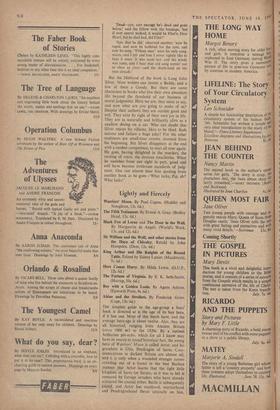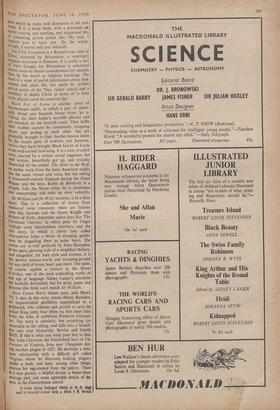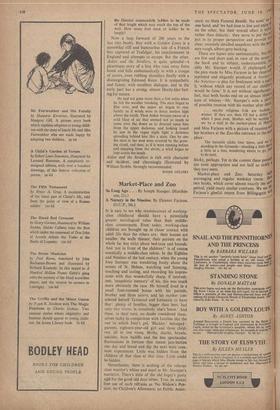Lightly and Fiercely
The Fifth Testament. By Ernest A. Gray. (Bodley Head, 12s. 6d.) Sir William and the Wolf, and other stories from the Days of Chivalry. Retold by John Hampden. (Dent, 12s. 6d.)
The Fortune of Virginia. By E. K. Seth-Smith. (Harrap, 10s. 6d.)
Boy with a Golden Louis. By Agnes Ashton. (Epworth Press, 9s. 6d.) Aldan and the Strollers. By Frederick Grice. (Cape, 13s. 6d.)
THE simplest guide to the age-group a boys' book is directed at is the age of its boy hero, if it has one. Most of this batch have, and the average hero-age is about twelve. Also, they are all historical, ranging from Ancient Britain (circa 1000 BO to the 1820s. By a curious Arthurian pre-echo, which for all 1 know may have its source in sound'historical fact, the young hero of Warriors' Moon is called Artor, and his grandsire is Utta, Pendragon of Sarm. Com- munications in darkest Britain are almost nil, and it is only when a Wounded stranger comes crawling out of a forest in the best Buchan manner that Artor learns that the tight little kingdom of Sarm (or Sarum, as it was to be) is menaced by foreign invaders who have already scattered the coastal tribes. Battle is subsequently joined, and Artor has manhood, warriorhood and Pendragonhood thrust untimely on him, after which he copes with dissension in his own ranks. It is a noisy book, with a premium on tll'1OIY roaring and snarling, and occasional bits of interesting period syntax like 'My lord, I iMplore you to tarry not: On the whole. though, it moves well and unfussity. _T Fifth Testament is a Roman's-eye view of Christ, narrated by Britannicus, a veterinary sergeant stationed in Palestine. It is really a sort of Vet's Gospel, for Britannicus is converted almost more by Jesus's consideration for animals than by his moral or religious teachings. The hook is a mine of useful information about bird. animal and plant life, but spoilt by terrible Period patter of the 'Nay, rather' school and a tendency to depict Christ in terms of 'a faint snnle played round his sensitive lips.'
Black Fox of Lorne is another piece of Iluchanesque uplift, in which a pair of identi- blond and beamish Norse twins `go a- vtking' (in their father's horrible phrase) and are wrecked on the Scottish coast. They baffle their wolfish captors by continually swapping Places and posing as each other, but are gradually brought to their heather-beaten knees by the simple piety of crofters; not, however, before they have brought Black Gavin of Lorne to his well-earned reckoning. It is a nice, eventful story, marred by a certain moral sogginess, but well written, beautifully got up, and stylishly illustrated by the author. The Door hi the Wall, an earlier work from the same American stable, has the same virtues and vices, but the setting is fourteenth-century England during the Great Plague, and the hero, Robin de Bureford, is a cripple. Like the Norse twins, he is passionate and enterprising, and ends up most valiantly. Sir William and the Wolf, however, is in a class apart. This is a collection of stories from medieval verse romances; there are famous ones like Gawain and the Green Knight and Robert of Sicily, delectable minor joys like 'The Christmas Cherries,' in which poor Sir Cleges wallops some discourteous courtiers, and the title story, in which a clever lady called Alexandrine helps a braCe of escaping gentle- Men by disguising them as polar bears. The stories are 're-told' perfectly by John Hampden, in the spare, glowing style of a simplified Malory; and altogether, for both style and content, it is the perfect fantasy-world and stamping-ground for any child of brain, heart and sinew. The same, of course, applies a fortiori to the Morte d Arthur, one of the most enthralling works of any age or language. Sidney Lanier's selections are tactfully dovetailed; but for print, paper and Pictures this book can't match Sir William.
Here Comes Harry means poor, pale Henry VI; it also, in this story, means Henry Rushden, an impoverished gentleboy apprenticed to a Foldsmith, who schemes and prowls to save the infant King (only four when we first meet him) from the wiles of ambitious Protector Glouces- ter. The story is scholarly, but something too Mournful in the telling, and falls into a breath- less awe over Monarchy, Service and Gentle Birth. If this is what you want your boy to feel, fine. John Cluverius, the Dutch-bred hero of The P. ortune of Virginia, lives near Cheapside dur- ing another plague in 1627. He develops a love- hate relationship with a difficult girl called Virginia whom he discovers looking plaguey tinder a bush, and later, among other things, ?eseues her egg-stained from the pillory. There is a nice granny, a helpful doctor, a better-than- average plot, and some agreeable details of les- sons at the Charterhouse school.
A town being besieged which is 36 ft, high and is moated round with a ditch r ft, broad, the General commandeth ladders to be made of that length which may reach the top of the wall. How many foot must ye ladder be in length?
Now a leap forward of 200 years to the last two books. Boy with a Golden Louis is a somewhat stiff and humourless tale of a French boy captured at Trafalgar, his imprisonment in England and attempts to escape. But the other, Aidan and the Strollers, is quite splendid—a picaresque story of a boy who runs away from home and falls enthusiastically in with a troupe of actors, even rubbing shoulders finally with a disintegrating Edmund Kean. It is sympathetic and funny, with excellent dialogue, and in the early part has a strong, almost Hardy-like-feel- ing for nature.
He had not gone more than a few miles when he felt the weather breaking. The stars began to film over, and the upper air began to roar faintly as if winds were in fierce motion high above the heath. Then Aidan became aware of a cold blast of air that seemed not so much to come over the down as to descend upon him from the upper darkness, and looking round he saw in the vague night light a darkness spreading behind him like a stain. One by one the stars in the west were covered by the grow- ing cloud, and then, as if it were running before and escaping from the storm, a wind began to lope across the heath.
Aidan and the Strollers is rich with character and incident, and charmingly illustrated by William Stobbs. Strongly recommended.
ROGER GELLERT












































 Previous page
Previous page